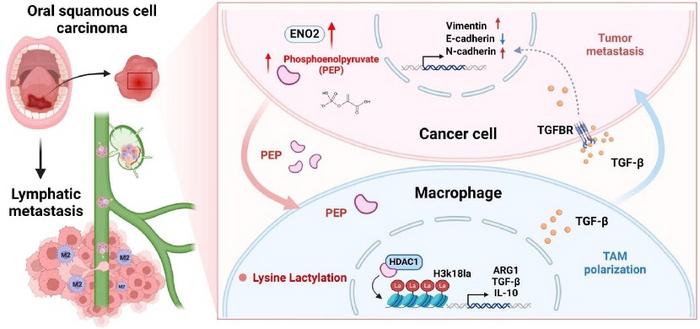A recent and groundbreaking study highlights the significant role of enolase 2 (ENO2) in the progression of head and neck squamous cell carcinoma (HNSCC), one of the most aggressive forms of cancer. This study, published in the journal Engineering, unveils new insights into how this glycolytic enzyme has a direct correlation with lymphatic metastasis, a key factor that drastically lowers the survival rate in HNSCC patients. The research team carried out a comprehensive analysis integrating various tumor databases, public datasets, and clinical relevance assessments, resulting in revelations that could lead to novel therapeutic strategies.
HNSCC is notoriously difficult to treat, with the majority of patients facing a grim prognosis, as cervical lymph node metastasis is a leading cause of fatalities linked to this disease. Currently, effective therapies for metastatic variants of HNSCC remain elusive. Recognizing the urgent need for innovative approaches, the authors focused their attention on ENO2 and its effects on tumor behavior. They discovered that elevated levels of ENO2 within tumor cells corresponded positively with the incidence of lymph node metastasis.
The mechanistic pathway leading from ENO2 to metastatic potential was determined to involve the promotion of cellular migration and invasion. This transition is classified as the epithelial-mesenchymal transition (EMT), a pivotal process in which epithelial cells lose their characteristics and gain migratory and invasive traits. The research establishes a clear link between ENO2 overexpression and increased EMT, providing a direct pathway through which tumor aggressiveness is facilitated.
Moreover, the study delved deeper into the metabolic aspects of ENO2, revealing its influence on the tumor microenvironment, particularly concerning macrophage behavior. The findings demonstrate that ENO2 contributes to the polarization of M2 macrophages, a subtype that generally supports tumor development and metastasis. The metabolite phosphoenolpyruvate (PEP) is produced in abundance due to heightened ENO2 activity, and this particular metabolite is shown to enhance histone modifications which are critical for regulating gene expression.
Specifically, PEP was found to inhibit histone deacetylase 1 (HDAC1), which subsequently increases levels of histone H3 lysine 18 lactylation (H3K18la). This modification is crucial in favoring the transcription of genes associated with M2 macrophage polarization. The increased presence of M2 macrophages in the tumor microenvironment further exacerbates EMT and supports the migratory capabilities of HNSCC cells. The interaction between TGF-β, a cytokine secreted by these polarized macrophages, and its receptor on tumor cells initiated further promoting invasiveness and metastasis.
In an exciting twist, the research team also explored pharmacological options to mitigate ENO2’s negative impact. Utilizing POMHEX, an inhibitor of ENO2, displayed promising results. This intervention significantly reduced M2 macrophage polarization and effectively hindered lymphatic metastasis in mouse models. Such findings present POMHEX as a potential therapeutic avenue for combating the spread of HNSCC, providing hope for developing more effective treatment strategies.
The elucidation of ENO2’s role in the modulation of macrophage polarization and subsequent metastasis to lymph nodes paints a clearer picture of HNSCC progression. The study highlights the importance of understanding the biochemical and genetic interplay within the tumor microenvironment. It underscores how shifts in cellular metabolism, particularly through metabolic enzymes like ENO2, can have cascading effects that facilitate tumor growth and spread.
This research contributes significantly to our knowledge of how metabolic pathways govern the interactions between tumor cells and immune cells in their vicinity. By delineating these pathways, scientists aim to open new doors in the battle against HNSCC and potentially other forms of cancer characterized by similar metabolic alterations. Future investigations can build upon these findings to explore how systematic therapies can target these pathways effectively.
The impactful study, titled “Cancer ENO2 Induces Histone Lactylation-Mediated M2 Macrophage Polarization and Facilitates Metastasis of Head and Neck Squamous Cell Carcinoma,” represents a significant stride toward unraveling the complexities of tumor biology. It instills a renewed perspective on how metabolic enzymes can be utilized as therapeutic targets to disrupt metastatic pathways in cancers that are currently poorly managed.
As we look toward the future, the insights gained from this research cultivate hope that a deeper understanding of metabolic mechanisms could pave the way for successful interventions in HNSCC. It also exemplifies how collaborations across molecular biology, clinical research, and pharmacology can yield powerful tools against aggressive malignancies. With the continuous evolution of cancer research, this study is a testament to the potential of innovative approaches in redefining treatment paradigms.
This work emphasizes a collective movement within the scientific community towards more nuanced understandings of cancer mechanisms, integrating traditional understandings of oncology with emerging discoveries from the fields of metabolism and immunology. By harnessing the latest research methodologies and clinical insights, the fight against HNSCC—and indeed other types of cancer—could soon achieve a transformative shift.
Strong efforts and continuous research in this area could enable clinicians and researchers to develop targeted therapies that address not just the tumor cells themselves but also the supportive cells in their environment, ultimately aiming for a more comprehensive approach to cancer treatment. The future of HNSCC treatment may lie in the convergence of these newly understood mechanisms, presenting a holistic pathway for innovation and healing.
As the scientific community continues to unravel the complexities of cancer biology, studies like these will drive home the message that aggressive forms of cancer require equally robust responses, rooted in an understanding that is increasingly intricate and multifaceted. These findings are hope-driven, aiming not just towards understanding cancer better, but ultimately towards conquering it.
Subject of Research: ENO2’s Role in HNSCC Metastasis
Article Title: Cancer ENO2 Induces Histone Lactylation-Mediated M2 Macrophage Polarization and Facilitates Metastasis of Head and Neck Squamous Cell Carcinoma
News Publication Date: 6-Jan-2025
Web References: DOI link
References: N/A
Image Credits: henran Wang et al.
Keywords: ENO2, HNSCC, lymphatic metastasis, macrophage polarization, TGF-β, PEP, EMT, cancer research, therapeutic targets.




